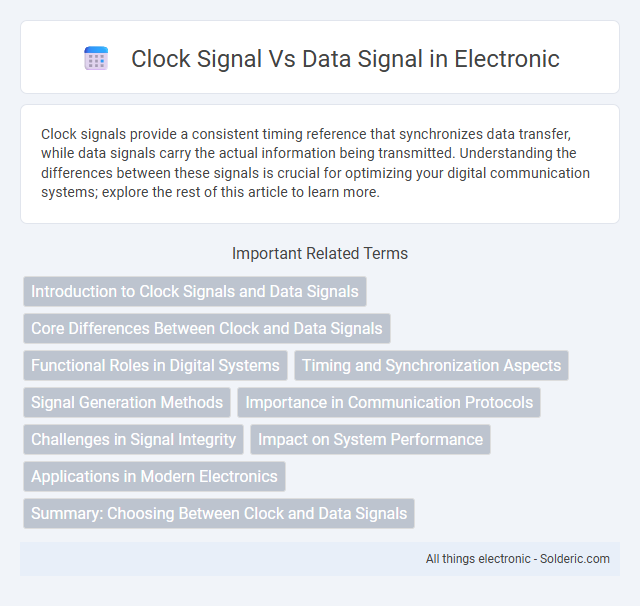Clock signals provide a consistent timing reference that synchronizes data transfer, while data signals carry the actual information being transmitted. Understanding the differences between these signals is crucial for optimizing your digital communication systems; explore the rest of this article to learn more.
Comparison Table
| Feature | Clock Signal | Data Signal |
|---|---|---|
| Purpose | Synchronizes timing of operations | Transports actual information or data |
| Nature | Periodic, consistent frequency | Variable, depends on information content |
| Waveform | Typically square wave | Can be varied (digital or analog) |
| Role in Communication | Coordinates data transfer timing | Carries meaningful bits or signals |
| Examples | System clock, CPU clock | Binary data, serial data streams |
| Frequency | Fixed or well-defined | Variable, depends on data rate |
Introduction to Clock Signals and Data Signals
Clock signals provide a consistent timing reference essential for synchronizing operations within digital circuits, enabling precise coordination of data transfer. Data signals carry the actual information being processed or transmitted, representing binary values that change based on the clock's timing intervals. Understanding the distinction between clock and data signals is crucial for optimizing the performance and reliability of your digital communication systems.
Core Differences Between Clock and Data Signals
Clock signals provide a consistent timing reference that synchronizes data transfer within digital circuits, operating at fixed frequencies to coordinate actions precisely. Data signals carry actual information content, varying dynamically according to the transmitted data bits, and are often asynchronous relative to the clock. The core difference lies in function: clock signals enable timing control, while data signals convey the message or information being processed.
Functional Roles in Digital Systems
Clock signals synchronize the timing of operations by providing a consistent pulse that coordinates data transfer and processing within digital circuits. Data signals carry the actual information being processed or transmitted, representing binary values essential for computation. Your digital system relies on the precise interplay between clock and data signals to ensure accurate and reliable functionality.
Timing and Synchronization Aspects
Clock signals provide a precise timing reference that synchronizes data signals across digital circuits, ensuring proper sequencing and reliable communication. Data signals carry the actual information, and their validity is determined relative to the clock signal's edges, typically rising or falling transitions. Accurate timing relationships between clock and data signals minimize setup and hold time violations, which are critical for preventing data corruption and maintaining system stability.
Signal Generation Methods
Clock signals are typically generated using crystal oscillators, phase-locked loops (PLLs), or clock generators that provide stable, periodic timing pulses essential for synchronizing circuits. Data signals, in contrast, originate from logical circuits or sensors, encoding information as varying voltage levels or digital states in response to input or processing events. Your system's performance relies on precise clock signal generation coupled with accurate data signal timing to ensure reliable communication and processing.
Importance in Communication Protocols
Clock signals synchronize data transmission, ensuring that data signals are accurately timed and interpreted within communication protocols. Precise clock signals minimize errors by coordinating sender and receiver timing, which enhances data integrity and system reliability. Your communication system's performance heavily depends on the harmonious interaction between clock and data signals for seamless data transfer.
Challenges in Signal Integrity
Clock signals, characterized by their consistent periodic timing, face challenges such as jitter and skew that can disrupt synchronization across digital circuits. Data signals, which carry variable information, are more prone to noise, attenuation, and crosstalk, complicating accurate data interpretation. Ensuring signal integrity requires precise impedance control, effective shielding, and proper termination to minimize distortion and timing errors in both clock and data lines.
Impact on System Performance
Clock signals provide synchronized timing essential for coordinating data transfer in digital systems, ensuring reliable and predictable performance. Data signals carry the actual information but depend on the clock signal's accuracy to prevent timing errors and data corruption. Variations or jitter in the clock signal can significantly degrade system performance by causing misalignment in data sampling and processing.
Applications in Modern Electronics
Clock signals synchronize operations in microprocessors, digital circuits, and communication systems by providing a precise timing reference essential for data processing and transfer. Data signals carry information between components, enabling instruction execution, sensor readings, and user interactions within devices like smartphones, computers, and IoT gadgets. Your understanding of the distinct roles of clock and data signals enhances the design and troubleshooting of modern electronics, ensuring efficient and reliable system performance.
Summary: Choosing Between Clock and Data Signals
Clock signals provide timing references essential for synchronizing data transfer, while data signals carry the actual information within digital circuits. Your choice depends on the system's design requirements, where stable timing precision favors clock signals and flexible data handling requires robust data signals. Understanding their complementary roles ensures optimal performance in communication and processing tasks.
clock signal vs data signal Infographic

 solderic.com
solderic.com